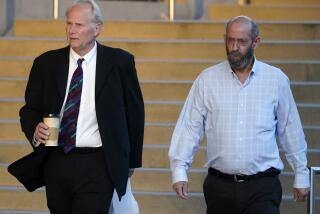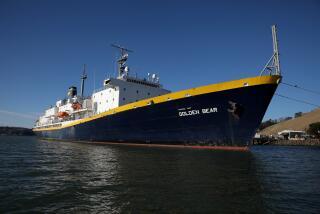Hazelwood’s Sea License Suspended for 9 Months
- Share via
An administrative law judge on Wednesday suspended for nine months the seaman’s license of the former skipper of the Exxon Valdez, Capt. Joseph Hazelwood, after he pleaded no contest to violations of U.S. Coast Guard maritime rules arising out of the nation’s worst oil spill last year in Alaska.
A charge that Hazelwood’s blood-alcohol content was above the service’s permissible level of 0.04% was dropped, however, amid allegations by the captain’s lawyers that local prosecutors in Alaska and federal officials covered up Hazelwood’s blood test results.
Hazelwood pleaded no contest to “wrongfully” consuming alcoholic beverages “within four hours” of leaving port and “negligently” departing the bridge while the vessel was heading toward Bligh Reef.
The no-contest plea was, in effect, an admission of guilt for purposes of the license hearing, and his lawyers said it could not be used as ammunition in dozens of civil cases pending against Hazelwood.
The lawyers, Michael Chalos and Thomas Russo, said the Coast Guard decided to drop the charge of inebriation during recent closed-door plea-bargaining sessions when documents surfaced appearing to show that the blood test was either botched or altered by a Sacramento laboratory.
The documents, which Hazelwood’s lawyers say they saw for the first time only a few weeks ago, appear to show discrepancies in how the captain’s blood was inventoried and whether, indeed, it was his blood.
Both at the civil hearing in Long Beach and at a news conference afterward, the attorneys said that if the blood test documents had been produced before Hazelwood’s criminal trial in Alaska, the case against him as a “drunken sea captain” would have crumbled.
Discovery of the documents, Russo said, “should put the nail in the coffin for good in terms of Hazelwood being intoxicated at the time of the grounding.”
After the hearing, Hazelwood told the Associated Press that he was elated over the discovery of the documents.
“It’s what we said all along and nobody would listen to us,” he said. “The possible skulduggery that goes along with it is enough to make anybody angry. If if weren’t for our discovery of this, it would have been buried forever and a lot of people with political agendas would have been very happy.”
In addition to suspending his seaman’s license, Administrative Judge Harry J. Gardner put Hazelwood on 12 months probation at the end of a daylong hearing.
Hazelwood was captain of the tanker Exxon Valdez when it ran aground at Bligh Reef in Alaska’s Prince William Sound at 12:04 a.m. on March 24, 1989. Approximately 11 million gallons of crude oil gushed from its ruptured hull, the nation’s worst oil spill.
More than 1,000 miles of Alaskan shoreline was coated with oil. Commercial fishing in the area was ruined for the year, and the cleanup is still under way. Hazelwood was fired by Exxon Corp. shortly after the results of his blood test were sent to the Coast Guard. Since then, he has been involved in a lobstering business.
At his criminal trial in Anchorage, the cornerstone of the charges by Alaskan prosecutors was that Hazelwood was drunk when he took command of his tanker on the evening of March 23, before it left the port of Valdez.
Hazelwood did not testify at the trial. Through his attorneys, he acknowledged drinking before sailing out of Valdez, but the amount he consumed was disputed. Not one of 21 witnesses--most of them called by the prosecution--testified to any signs that the captain was drunk the night his ship ran aground.
The key sobriety test, taken 10 hours after the grounding, indicated that the captain’s blood alcohol level was 0.06%, slightly above the Coast Guard’s permissible level of 0.04%, but well below Alaska’s 0.10% minimum standard.
Hazelwood’s seven-week criminal trial concluded last March 23. An Anchorage jury acquitted him of three criminal charges--including operating a vessel while intoxicated--that carried maximum penalties of seven years in jail. He was convicted of negligent discharge of oil, a misdemeanor, and ordered to spend 1,000 hours helping to clean up Prince William Sound shores.
Wednesday’s civil hearing had nothing to do with the criminal trial. Its purpose was to determine whether Hazelwood’s marine license should be suspended.
At the outset of the hearing, the Coast Guard announced it was dropping two of four allegations against him: that he was inebriated while operating the tanker and that he turned the ship over to a third mate who did not have the proper pilot certificate to navigate Prince William Sound.
Hazelwood, dressed in a blue blazer and khaki pants, sat quietly with his lawyers throughout the hearing and did not testify.
Hazelwood had said in an interview after his Alaskan trial that he “wasn’t equipped” to be the focus of so much media attention. “I’m Joe Schmoe, you know, just a boat driver, basically.”
But again, on Wednesday, Hazelwood was the subject of intense media scrutiny. The small courtroom in a downtown Long Beach bank building was packed and the media overflow had to be accommodated in another room with closed-circuit television.
Chalos told the hearing that his client was a man of rare attributes who did not deserve the worldwide criticism that had made him a scapegoat for the disaster.
“What you have here is a very, very special man who has been vilified and humiliated in the last 16 months,” Chalos told the hearing. “He has never, ever blamed any of his shipmates.”
Hazelwood, Chalos said, was “a competent, highly skilled captain” who “has suffered enough. He wants to do what he knows best--to be a ship’s captain. . . . He wants to go back to sea . . . as soon as possible.”
Chalos branded the criminal proceeding in Alaska “a show trial” during which the state’s prosecutors attempted to portray Hazelwood as “a drunken sea captain.”
But Chalos said that depiction can no longer stand in light of the newly discovered documents, which were filled out by the Sacramento firm ChemWest Analytical Laboratories, a subsidiary of North Carolina-based CompuChem Corp.
At Hazelwood’s criminal trial, Coast Guard Health Services Technician 1st Class Scott M. Conner said he performed blood tests on the Exxon Valdez crew--including Hazelwood--the morning after the oil spill. He said he placed Hazelwood’s blood into three glass tubes--two with gray rubber stoppers and a third with a red stopper.
The gray-topped tubes contained a preservative to keep alcohol in the blood from, in effect, fermenting and reaching higher levels with the passage of time. Without the preservative, there could be a false reading. The red-topped tube does not need the preservative because the sample is used to see if drugs are in the blood.
According to ChemWest’s records, copies of which have been given to The Times, there appears to be a discrepancy as to what actually was tested and whether the tests were altered.
One document shows that instead of receiving one red and two gray tubes, ChemWest had three sealed red-topped tubes of Hazelwood’s blood.
Chalos and Russo claim that if this is true, the lab could not have tested Hazelwood’s blood for alcohol content.
Another document appears to have been altered.
Instead of logging in three red tubes, the number 3 is crossed out and a 1 is written above it. The change is dated May 1, 1989--more than a month after the oil spill and after the lab received the blood samples.
Underneath this notation, two gray tubes of blood have been logged in--agreeing with Coast Guard technician Conner’s testimony.
Another apparent discrepancy on both ChemWest forms refers to the size of the tubes Conner used to take the blood samples. Conner testified that the tubes he used had a 15-milliliter capacity. The tubes logged on the ChemWest inventory sheet have a 10-milliliter capacity.
Asked to respond to these apparent discrepancies, the director of the laboratory, Michael Peat, said “there was no tampering done with the specimens.” He declined to elaborate.
Attorneys Chalos and Russo told the news conference that the district attorney’s office in Anchorage “knew they had a bogus (blood) test. They covered it up.” They also leveled a similar cover-up charge against the National Transportation Safety Board, which investigated the oil spill. The lawyers claimed the board knew about the apparent discrepancies at ChemWest.
A board spokeswoman, Drucella Andersen, said the agency never had physical possession of the blood specimens. She added that this was the first time since the disaster that she has heard of complaints from Hazelwood’s lawyers about the blood-testing procedures.
One of two assistant district attorneys in Alaska who prosecuted Hazelwood, Mary Anne Henry, said in a telephone interview from Anchorage that nothing was illegally withheld from Hazelwood’s lawyers in preparation for the criminal trial. Moreover, she said, we “never saw any documents that would have reflected a problem with the blood testing nor were we advised of any problems.”
Soble reported from Long Beach and Rempel from New York City.
More to Read
Sign up for Essential California
The most important California stories and recommendations in your inbox every morning.
You may occasionally receive promotional content from the Los Angeles Times.










